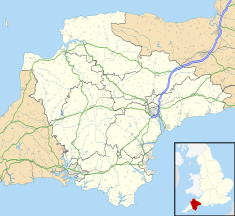Bickleigh Castle
| Bickleigh Castle | |
|---|---|

Bickleigh Castle, Gatehouse
|
|
| Location | Bickleigh in Devon, England |
| Coordinates | 50°51′05″N 3°30′45″W / 50.85139°N 3.51250°WCoordinates: 50°51′05″N 3°30′45″W / 50.85139°N 3.51250°W |
|
Listed Building – Grade I
|
|
| Official name: Bickleigh Castle Gatehouse | |
| Designated | 28 August 1987 |
| Reference no. | 1325638 |
|
Listed Building – Grade II*
|
|
| Official name: Bickleigh Castle chapel - including walls to enclosure to south and west | |
| Designated | 28 August 1987 |
| Reference no. | 1325639 |
|
Listed Building – Grade II*
|
|
| Official name: Old Court | |
| Designated | 24 October 1951 |
| Reference no. | 1106959 |
|
Listed Building – Grade II
|
|
| Official name: Bickleigh Castle, north range | |
| Designated | 28 August 1987 |
| Reference no. | 1170452 |
Bickleigh Castle is a fortified manor house that stands on the banks of the River Exe at Bickleigh in Devon, England. Once considerably larger, Bickleigh now comprises a group of buildings from various periods which together formed a water castle.
The main building was destroyed during the English Civil War, however other buildings, mostly arranged around a central courtyard survive, although frequently restored and revised survive. The castle has been open to the public and now serves as a wedding venue and provides holiday rentals.
A Norman motte castle of the late 11th or early 12th century was dismantled in the mid 12th century. During this time a small stone chapel was built in the bailey. In the 15th century the Courtney family built a mansion on the site and incorporated some of the earlier buildings. The Carew family then lived there for over two centuries.
During the English Civil War Charles I's queen, Henrietta Maria stayed in the castle until word was received that Fairfax's Parliamentarian troops were approaching, following which she fled to France. The bulk of the castellated structure was then demolished by Parliamentarian troops. The 'slighting' of Bickleigh was a response to the Royalist sympathies of the Carew family and its use as a stronghold during the conflict with the main manor house and inner keep being destroyed.
Following the Restoration, a typical Devon farmhouse of cob and thatch was added.
The buildings subsequently fell into disrepair, and became a farm store and cottage until they were restored early in the 20th century. The Norman chapel and a 14th-century gatehouse still exist.
...
Wikipedia

